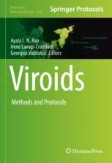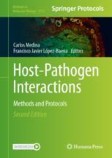Search
Search Results
-
Dot-Blot Hybridization Technique
The dot-blot hybridization is a nucleic acid hybridization technique where complementary single-stranded sequences of the probe (either RNA or DNA)...
-
Liquid and Solid Hybridization Methods to Detect RNAs
Northern blotting (NB) has been a long-standing method for RNA detection. However, its labor-intensive nature, reliance on high-quality RNA, and use...
-
Tissue Print Hybridization for Detection and Characterization of Viroids
Simplifying sample preparation by transferring plant sap (from plant sections) directly onto a membrane is advantageous for any routine viroid...
-
RNA In Situ Hybridization on Plant Tissue Sections: Expression Analysis at Cellular Resolution
RNA in situ hybridization offers a means to study the spatial expression of candidate genes by making use of specific, labelled RNA probes on thin...
-
Detection of TERRA R-Loops at Human Telomeres
R-loops are three-stranded nucleic acid structures composed of a DNA–RNA hybrid and a displaced DNA strand. The long noncoding RNA TERRA forms...
-
In Situ Hybridization of Estrogen Receptors α and β in the Human Testis
In situ hybridization (ISH)In situ hybridization (ISH) is an excellent method for detecting RNA in histological sections, both to detect gene...
-
Molecular evidence of Apple Stem Grooving Virus infecting Pear in India
Pear leaf samples exhibiting severe virus-like symptoms (such as distortion, chlorosis, chlorotic spots, marginal chlorosis and necrotic spots) were...

-
Replicase gene mediated RNA silencing mechanism confers resistance against groundnut bud necrosis virus in tomato (Lycopersicon esculentum Mill.)
Groundnut bud necrosis virus (GBNV), a member of the genus Orthotospovirus , is the most devastating pathogen causing bud blight of tomato and causes...

-
Development of an isothermal reverse transcriptase-recombinase polymerase amplification assay for the rapid diagnosis of four viroids in different grape cultivars
Rapid, isothermal detection is possible using recombinase polymerase amplification assay (RPA) offering great specificity plus sensitivity. An RPA...

-
Analysis of sRNAs and Their mRNA Targets in Sinorhizobium meliloti: Focus on Half-Life Determination
Regulation of gene expression at the level of RNA and/or by regulatory RNA is an integral part of the regulatory circuits in all living cells. In...
-
N6-methyladenosine demethylase FTO regulates synaptic and cognitive impairment by destabilizing PTEN mRNA in hypoxic-ischemic neonatal rats
Hypoxic-ischemic brain damage (HIBD) can result in significant global rates of neonatal death or permanent neurological disability....

-
The discovery of multiple active mys-related LTR-retroelements within the Neotominae subfamily of cricetid rodents
Retrotransposon families in the rodent family Cricetidae have been understudied in contrast to Muridae, both taxa classified within the superfamily...

-
Differential amplification of the subtelomeric satellite DNA JcSAT1 in the genus Jatropha L. (Euphorbiaceae)
Satellite DNAs (satDNAs) are highly repetitive sequences that occur in virtually all eukaryotic genomes and can undergo rapid copy number and...

-
Endophytic Pseudomonas pseudoalcaligenes and arbuscular mycorrhizal fungi mediated anti-autophagy and induction of catalase and antioxidant enzymes in pigeon pea against fungal pathogen
One of the most harmful diseases that infect pigeon pea plants is Fusarium wilt caused by Fusarium udum . The novelty of this study was to investigate...

-
Common Bacterial Fish Diseases and Approaches on Molecular Techniques for Characterization and Early Detection of Pathogens
Cultural and serological tests are the earliest methods for the detection of diseases. The histological studies also help for the identification of...
-
Genomic and antibody-based assays for the detection of Indian strains of Macrobrachium rosenbergii nodavirus and extra small virus associated with white tail disease of Macrobrachium rosenbergii
White tail disease (WTD) of cultured Macrobrachium rosenbergii is caused by Macrobrachium rosenbergii nodavirus ( Mr NV) and extra small virus (XSV)....

-
Protecting potato plants against PVX and PVY viral infections by the application of native and chemically modified legume proteins
Methylated soy and chickpea proteins (MSP and MCP, respectively), and 11S globulin (a soy protein fraction), are characterized by net positive...

-
Molecular and morphological evaluation of transgenic Persian walnut plants harboring Fld gene under osmotic stress condition
BackgroundSoil drought stress is a limiting factor of productivity in walnut ( Juglans regia L). Ferredoxin (Fd) level decreases under adverse...

-
A Workflow for the Functional Characterization of Noncoding RNAs in Legume Symbiotic Bacteria
Computational comparative genomics and, later, high-throughput transcriptome profiling (RNAseq) have uncovered a plethora of small noncoding RNA...
-
Engineering of insecticidal hybrid gene into potato chloroplast genome exhibits promising control of Colorado potato beetle, Leptinotarsa decemlineata (Coleoptera: Chrysomelidae)
The potato chloroplast was transformed with codon optimized synthetic hybrid cry gene ( SN19 ) to mitigate crop losses by Colorado potato beetle (CPB)....

